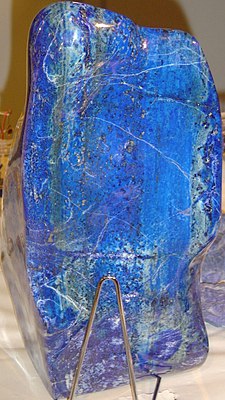| Lapis lazuli | |
|---|---|
 A polished specimen of lapis lazuli. |
|
| General | |
| Category | Rock |
| Chemical formula |
mixture of minerals |
| Identification | |
| Color | Blue, mottled with white calcite and brassy pyrite |
| Crystal habit |
Compact, massive |
| Crystal system |
None, as lapis is a rock.Lazurite, the main constituent, frequently occurs as dodecahedra |
| Fracture |
None |
| Fracture |
Uneven-Conchoidal |
| Mohs scale hardness |
5–5.5 |
| Luster |
dull |
| Streak |
light blue |
| Specific gravity |
2.7–2.9 |
| Refractive index |
1.5 |
| Other characteristics | The variations in composition cause a wide variation in the above values. |
Lapis lazuli ( lap-is laz-zew-lee) (sometimes abbreviated to lapis) is a relatively rare semi-precious stone that has been prized since antiquity for its intense blue color.
Lapis lazuli was being mined in the Badakhshan province of Afghanistan as early as the 3rd millennium B.C.E.[2] and there are sources that are found as far east as in the region around Lake Baikal in Siberia. Trade in the stone is ancient enough for lapis jewelry to have been found at Predynastic Egyptian and ancient Sumerian sites, and as lapis beads at neolithic burials in Mehrgarh, the Caucasus, and even as far fromAfghanistan as Mauritania.[3]
Description
Lapis lazuli is a rock, largely formed from the mineral lazurite.
The main component of lapis lazuli is lazurite (25% to 40%), a feldspathoid silicate mineral with the formula (Na,Ca)8(AlSiO4)6(S,SO4,Cl)1-2. Most lapis lazuli also contains calcite (white), sodalite (blue), and pyrite (metallic yellow). Other possible constituents: augite; diopside;enstatite; mica; hauynite; hornblende, and nosean. Some lapis lazuli contains trace amounts of the sulfur-rich löllingite variety geyerite.
Lapis lazuli usually occurs in crystalline marble as a result of contact metamorphism.
Etymology
Lapis is the Latin for "stone" and lazuli the genitive form of the Medieval Latin lazulum, which is taken from the Arabic لازورد lāzaward, which is from the Persian لاژورد lāzhward, the name of a place where lapis lazuli was mined. Taken as a whole, lapis lazuli means "stone of Lāzhward".
The name of the place came to be associated with the stone mined there and, eventually, with its color. The English word azure, the Frenchazur, the Italian azzurro, the Polish lazur and the Spanish and Portuguese azul are cognates.
Sources
Lapis lazuli is found in limestone in the Kokcha River valley of Badakhshan province in northeastern Afghanistan, where the Sar-e-Sang mine deposits have been worked for more than 6,000 years. Afghanistan was the source of lapis for the ancient Egyptian and Mesopotamian civilizations, as well as the later Greeks and Romans. During the height of the Indus valley civilization about 2000 BC, the Harappan colony now known as Shortugai was established near the lapis mines.
In addition to the Afghan deposits, lapis has been extracted for many years in the Andes (near Ovalle, Chile), the Lake Baikal region ofRussia; Siberia; Angola; Argentina; Burma; Pakistan; Canada; India; and in the USA in California and Colorado.
Alternatives
Lapis lazuli is commercially "synthesized" (actually simulated) by the Gilson process, using artificial ultramarine and hydrous zinc phosphates. It may be substituted by spinel or sodalite, or by dyed jasper or howlite.
Uses
Lapis takes an excellent polish and can be made into jewelry, carvings, boxes, mosaics, ornaments, and vases. It was also ground and processed to make the pigment ultramarine fortempera paint and, more rarely, oil paint. Its usage as a pigment in oil paint ended in the early 19th century when a chemically identical synthetic variety, often called French ultramarine, became available.
Historical usage
In ancient Egypt, lapis lazuli was a favorite stone for amulets and ornaments such as scarabs; it was also used in ancient Mesopotamia by the Sumerians, Akkadians, Assyrians, and Babylonians for seals and jewelry. Lapis jewelry has been found at excavations of the Predynastic Egyptian site Naqada (3300–3100 BC), and powdered lapis was used as eyeshadow by Cleopatra.[3] In ancient Mesopotamia, lapis artifacts can be found in great abundance, with many notable examples having been excavated at the Royal Cemetery of Ur (2600-2500 BC).
In ancient times, lapis lazuli was known as sapphire, which is the name that is used today for the blue corundum variety sapphire.
Color
The intense blue color is due to the presence of the S3- radical anion in the crystal. An electronic excitation of one electron from the highest doubly filled molecular orbital (No. 24) into the lowest singly occupied orbital (No. 25) results in a very intense absorption at λmax ~617 nm.






















